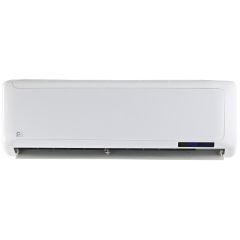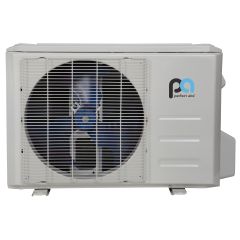Mini-Split Buying Guide
The only thing that might be better than the relief of air conditioning is stepping into a warm home from the Canadian winter! Get the “ahhhh” feeling from the heating and cooling of your ductless heat pump. Also called mini-splits, this type of system is ideal when you’re retrofitting a house with non-ducted heating or cooling systems, or you’re adding a new room to your home and extending or installing distribution ductwork is not possible. Mini-split pumps consist of an indoor evaporator, an outdoor condenser, a refrigerant line, and most systems include wireless control.
How does it work?
The heat pump works by extracting heat from the outside and bringing it inside. The refrigerant gas absorbs heat from the outside air and this heated gas gets passed to the indoor unit. When cooling, heat from the inside gets passed outside to be cooled by the outside unit.
In traditional air conditioner units, the rotary compressors run at full capacity and then power down. Once the temperature in the room starts to increase, the compressor will start running again at full capacity and then shut off when the desired temperature is reached. This creates large fluctuations between stop-start cycles.
A mini-split will deliver continuous heating or cooling that eliminates temperature variation and reduces your energy bill! An added benefit of inverter technology is that these types of units tend to be quieter and are less prone to breakdowns


Benefits
1. Easy Installation - No ductwork is required for mini-splits making it easy to install in spaces like basements and garages. However; DO NOT attempt to install your own heat pump without professional experience. Installation requires two small lines to carry refrigerant from the outdoor condenser to the indoor evaporator through a small 3” hole in the wall. Typically installed in only a few hours, some outdoor units can be located as far as 50’ away from the indoor evaporator. This makes it possible to cool rooms on the front side of the house, but keep the compressor tucked away in a more discreet location.
2. Quiet Operation - By dividing the heat pump into two units, the noisier component (the compressor) remains outdoors. Mini-split units can operate at sound levels as low as 19 dB... you may not even notice when it’s running!
3. Temperature Zoning - The ability to zone your home with a mini-split system gives you tremendous control and flexibility over your home’s environment and efficiency. Since each room has its own thermostat, you get perfect temperature control per room and only cool or heat spaces as needed. Controlling each heat pump zone independently provides increased comfort and flexibility that larger systems may lack.
4. Efficient & Eco-friendly - Energy efficient heat pump models can produce more heat energy than the electricity they consume. Mini-splits use advanced control algorithms, intelligently-designed heat exchangers, and inverter-driven compressors to save you more on energy bills. The lack of ductwork means less energy loss than central forced air systems: there is less than a 5% cooling loss in a mini-split’s insulated refrigerant lines compared to more than 30% through ductwork. Additionally, there is only a 3” hole in the outside wall, so you’ll experience less temperature loss than a window-mounted air conditioner unit. Units even come pre-charged with refrigerant which is designed to prevent the depletion of the ozone layer.
5. Design Flexibility - The indoor evaporator can be hung on a wall, suspended from a ceiling, or even mounted flush into a drop ceiling. In addition to the variety of mounting options, the unit itself has a sleek looking design and will easily blend into any room.




Drawbacks
1. Installation - The cost of installation may be higher since a qualified installer is necessary. This initial expense can be offset through lower operating costs, provincial or federal rebates, and other financial incentives. The installer is responsible for correctly sizing each indoor unit and deciding the best location options for their installation. By reviewing your requirements carefully, installers can help you avoid buying a unit that is too large or too small for your room to avoid poor temperature control and energy waste.
2. Appearance - While mini-splits are sleek and unobtrusive, these units do have a presence in your room as opposed to a central heating system.
3. Outdoor Placement - Snow is inevitable in Atlantic Canada, and it must be cleared from the outdoor unit. The condenser needs to be mounted at least 2’ above the ground to keep it out of the snow. In addition to mounting the unit above ground, it is best to keep the unit protected by a roof so air flow isn’t restricted and snow is kept off and away from the unit. There must also be a place for condensate water to drain near the outdoor unit. The ideal spot with these considerations may require a greater length of piping. Choosing a further location with extended piping will help reduce compressor noise in main areas of your home. Although heat pumps are quiet, they may be noisier than some other heating options
Mini-split heat pumps are a fantastic heating & cooling option for almost any space. Easily install new or retrofit your model with the help of a professional and enjoy consistent temperatures year round. Ask your local KENT expert about a model that will suit your space, and start saving on your energy bills!











